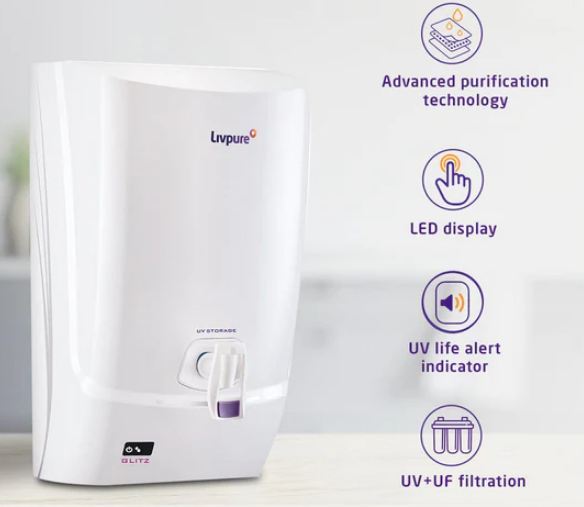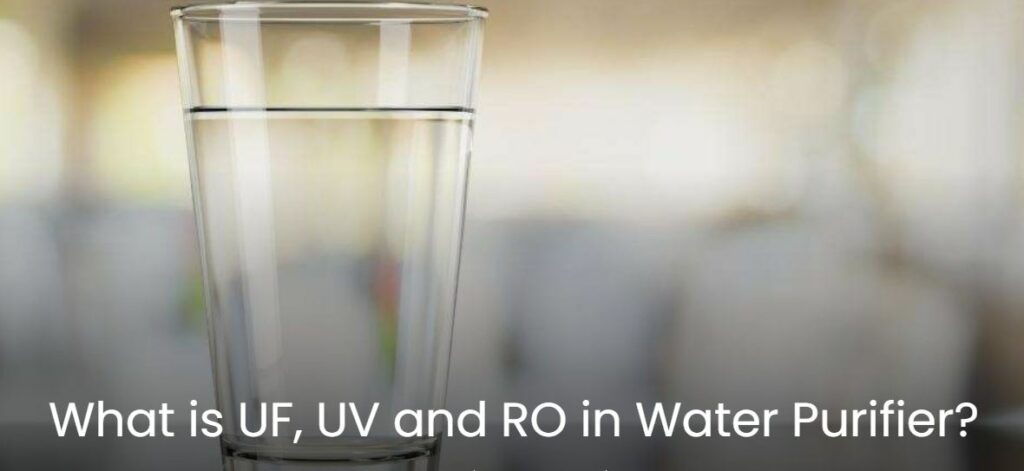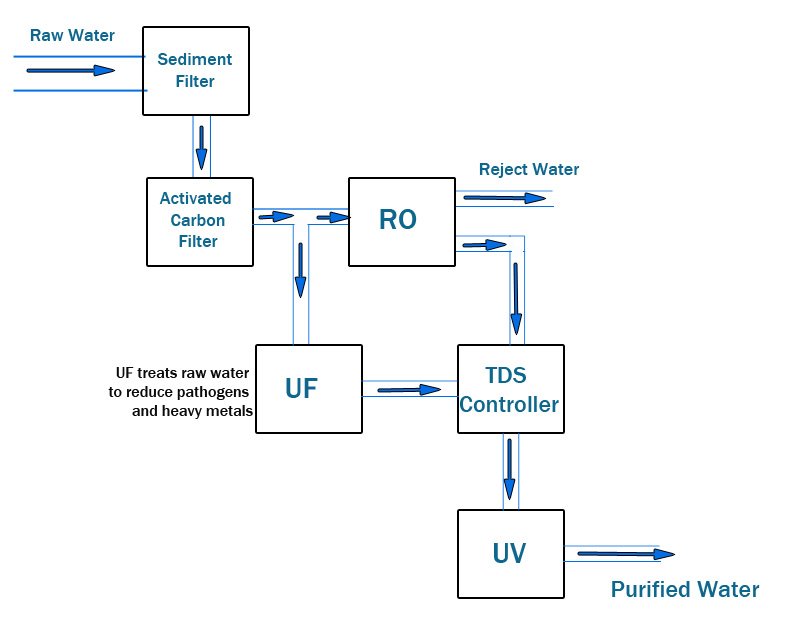Two of the most popular water purifier technologies are Ultraviolet (UV) and Ultrafiltration (UF). This article will explore what UV and UF in water purifiers are, how they work, and their differences.
Contents
- 1 UV and UF in water purifier
UV and UF in water purifier

With groundwater polluted by poison, company waste and septic systems, water treatment is necessary in India. But when you shop for a new water cleaner, you’ll probably bombard with a lot of jargon.
Here, we help you understand the key differences between UV and UF in water cleaners and the situation they best suit.
UV in water purifier
UV refers to the ultraviolet chamber through which water passes to kill bacteria, viruses and other germs. Its light produces electromagnetic energy that causes a chemical reaction in the RNA and DNA and kills them.

A large part of water purification includes a UV chamber, which is important in water cleaners. Some water cleaners have only UV technology, some have UV+UF, and some combine UV, UF and RO technology.
A water cleaner with only UV or UV+UF technology is appropriate when you have a water supply from a well. They are generally pure, pollution-free, and have a TDS (Total Dissolved Salts) level below 200 ppm. All you need is a final layer of refinement.
Pros and cons of using UV technology in water purification
One of the important advantages of UV technology is that it does not use any chemicals to purify water, making it a nature-friend water purification option. UV technology is relatively low cost, with most UV lamps only needing to be replaced every 6 to 12 months.
| Kills germs |  | ⨯ | ⨯ |
| Removes dissolved salt | ⨯ | ⨯ |  |
| Removes pathogens | ⨯ |  |  |
| Needs electricity |  | ⨯ |  |
| Water Pressure | Not required | Not required | Required |
| Membrane Size | NA | 0.02 – 0.05 microns | 0.0001 microns |
| Removes suspended impurities | ⨯ |  |  |
However, UV technology requires electricity to operate, and it is crucial to ensure that the water passes through the UV light long enough for a bacterium to kill. UV technology does not remove physical uncleanliness such as sand, dirt or ground from water.
UF in water purifier
UF stands for Ultra Filtration. Some brands also use the term MF, which stands for microfiltration. Here, water had passed through a UF membrane with a pore size of 0.02 – 0.05 microns. It is not enough to remove dissolved solids in water.
But it is perfect for removing large suspended particles. The main advantage of UF is that it does not waste water like RO.
As mentioned earlier, UV+UF microfiltration cleaners are suitable for households with municipal water supply. In such cases, the UF layer helps eliminate any residue from the water pipeline.
The UF layer performs different functions, removing RO water purifiers depending on their placement. In certain water treatments, the water first flows through the UF membrane and then to the RO layer.
An RO layer has a very small pore size of 0.0001 microns and captures anything treatments the UF layer captures. But, RO membranes are very expensive. If you leave all the purification to the RO layer alone, its lifespan will be very short. Moreover, the wastage of water is also high.
In some models of water cleaners, a UF layer had positioned to treat the raw water mixed with the RO-treated water to adjust the TDS. You may have read that most water purifiers have MTDS (Manual TDS Controller).
In such water treatment, the raw water separates into two after passing through the carbon filter. One part passes through the RO membrane, and the other passes through the UF membrane.
The fraction passing through the RO membrane contains very little TDS. So, the former is added to the RO water to increase the TDS to an acceptable level. As it passes through UF, pathogens and heavy metals are removed, and the output water is free of contaminants.
Pros and cons of using UF technology in water purification
One of the important advantages of UF technology is its ability to remove physical impurities from water sediment levels effectively UF technology can remove contaminants such as bacteria, viruses, sediment and other microorganisms from water. UF technology requires no chemicals to purify water, making it an environmentally friendly water purification option.
However, UF technology requires routine maintenance to prevent single membrane jams. The membrane jam of UF technology is also unsuccessful in removing dissolved solids such as minerals from water.
Difference between UV and UF in water purifier
When the water passes through the UV light that causes the bacteria, the viruses become idle, but their bodies remain in the water. These idle bacteria and virus bodies are not harmful to health.
Still, some bacteria and viruses are not 100% idle, and they re-evolve, reproducing their population, resulting in pollution of treated water.
But viruses had blocked the UF membrane in UF water purifier bacteria, and the purified water passed. Some bacteria and viruses may pass through the UF membrane and reach the treated water container and pollute the rest of the treated water.
See the Picture

In a UV water purifier, when the water is cloudy and turbid, the UV light rays cannot pass through the water, resulting in the water not purifying. In the worst case, sludge and mistiness get stuck on the UV lamp, making the UV light functional and water untreatable.
It had been considered a negative point of the UV water purifier. Most water cleaners offer a sediment filter or activated carbon prefilter to avoid these problems, specialized for removing insoluble solids such as mud and turbidity.
With these prefilters, UV water purifiers work expertly. The positive side of the UF water cleaner is that it is a master at purifying muddy, turbid water. UF is highly effective for treating muddy, turbid water.
UV or UF water purifiers fit low TDS (Total Dissolved Solids) water; raw, natural water contains sludge; turbidity goes to the UF water cleaner.
While UV had designed to kill bacteria, viruses, etc., it does not remove dissolved solids such as arsenic, fluoride, or lead. However, UF had designed to inhibit and remove bacteria, but not to remove let-go solids.
UF consists of a semi-permeable membrane made of hollow fibres with pores as large as 0.01 microns through which dissolved solids pass easily.
Conclusion
UF (Ultra Filtration) and UV (Ultraviolet) water cleaners have advantages and drawbacks. It is better to use UV and UF combination water cleaners. UV kills bacteria and viruses, but their bodies remain in the water caught by the UF water cleaners.
FAQs
Ultraviolet light kills all germs and bacteria in water. It makes things safe to drink as well as for other chosen purposes. Therefore, between UV and UF, UV is better.
Its UV+UF water purification system helps flush out illness-causing viruses and bacteria, giving you clean and safe drinking water. Its 11-watt high-power UV lamp kills and removes all microorganisms in the water, ensuring it is safe to drink.
UV filtration kills all viruses in the water. However, dead bacteria had been suspended in water. On the other hand, an RO water purifier kills bacteria and filters out their dead bodies floating in the water. Therefore, RO-treated water is cleaner.
You did not require UV purification for water cleaning, but a water filter had required before the UV system.

